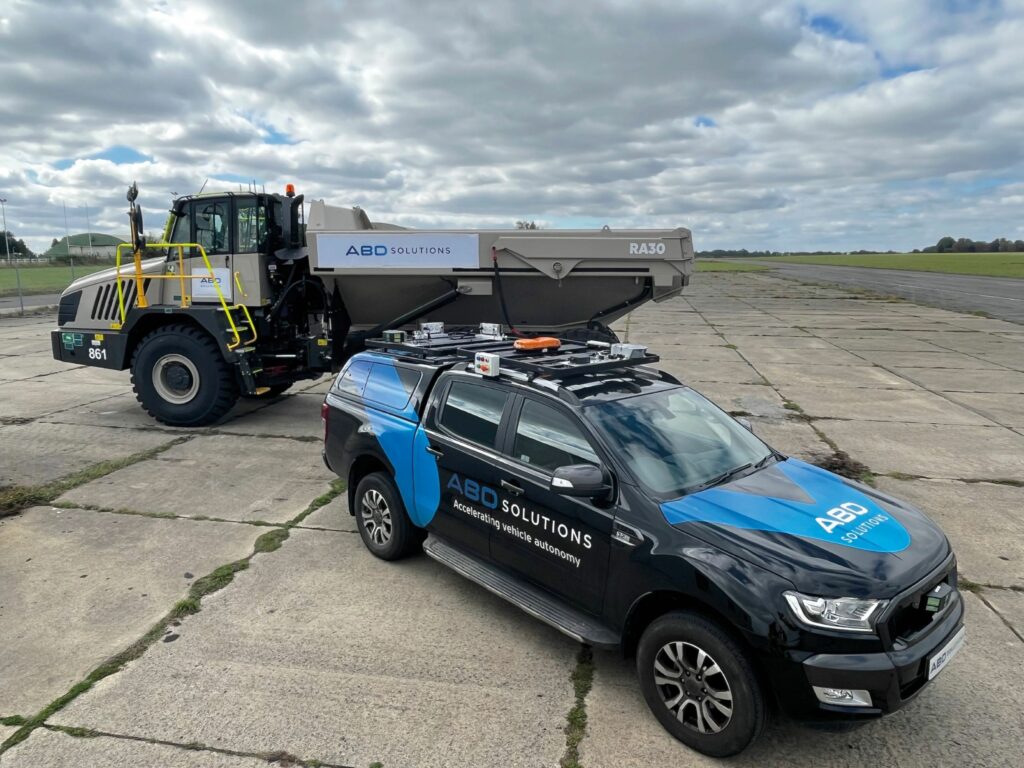Modular solution to conversion
ABD Solutions has developed a modular platform that can turn existing mining, agricultural and military vehicles into driverless ones (writes Nick Flaherty).
Indigo Drive is a complete autonomy solution that converts a vehicle to driverless operation using a central controller. The functional safety design is based around certified ECUs to handle the autonomous operation of the vehicle on a set path with a mission plan.

The conversion uses either mechanical actuators on the steering wheel, brake and accelerator pedals as well as arms to move the gears, or control via the vehicle’s CAN bus using the SAE J1939 protocol as well as an OBD2 diagnostics bus to monitor the activity of the vehicle. The underlying mechanical actuation IP comes from another company in the ABD Dynamics Group.
Matthew Price, managing director of ABD Solutions, said, “We take their technology and modify the robot systems for these markets. This includes a new user interface, detect and stop sensor technology integration and modified robot actuation systems. We have also increased the ingress protection ratings to meet the operation conditions and the need for a semi-permanent installation in the vehicle.”
The system is designed so that vehicles can also be driven. “The pedal robot is attached to the seat frame and offset, while the steering robot is mounted on the steering shaft underneath, and there are reaction arms and a frame to support the gear changes,” Price said.
A key requirement for the mining sector is that the whole cab is part of the safety cage, which means the system has to be designed around existing mounting points. The cabs of mining trucks also have to be sealed for air conditioning, so heat management is a crucial consideration for the ECUs.
A typical conversion uses cameras, Lidar and radar at the front and back of the vehicles and around the sides, controlled by a separate ECU. Another ECU handles secure communication of video and sensor data as well as diagnostic data back to a base station and positional data from GNSS constellations or other sensors. However, the conversion is configurable depending on the specific use case.
The comms can use an encrypted redundant mesh radio technology developed by ABD Solutions, for example in a mine, or other secure military comms systems. For more cost-sensitive applications such as agriculture or industrial material handling systems, the link can be 4G cellular.
An operator can monitor any of the live feeds from the vehicle and take control as required. One operator can monitor multiple vehicles in a fleet.
“Teleoperation is part of the core technology, for example to take manual control of a vehicle to keep it moving if there is an obstacle, but the main purpose is the pre-programmed operation,” Price said.
The fleet management function provides constant monitoring, selecting any vehicle at any time. An operator can access the video feeds from the vehicle alongside other data such as performance, location, diagnostics and fuel levels.
Cybersecurity has been designed into the system from the start. “What drives some of the technology is having the right level of separation and remote access,” Price said. “Part of that is showing that the solution meets the necessary levels of cybersecurity for the end-user.”
That leads to technology choices for the server used by the operator. The server can be cloud-based but it is expected that on-site servers will be preferred for more secure applications.
“The core software can manage numerous vehicles of varying types, the key constraint being the complexity of the operational environment and not the technology,” Price said.
The next stage of development is to use the data for detecting anomalies. Machine learning (ML) analysis of the data feeds can potentially identify problems with the vehicles before a problem becomes critical, to allow them to return to base for maintenance before a failure occurs. However, Price points out that existing maintenance schedules would still be followed, even with autonomous operation.
ABD Solutions is looking to work with partners and customers on the ML tools to achieve the anomaly detection.
“At this stage the data is provided to the customer’s server, and they will use it to find anomalies themselves,” Price said. “We are not looking to do everything ourselves, and there are data analytics partners we can get in touch with to provide that technology.
“We are doing the same with the electrification of the vehicles, indoor positioning and diagnostics.”
UPCOMING EVENTS























